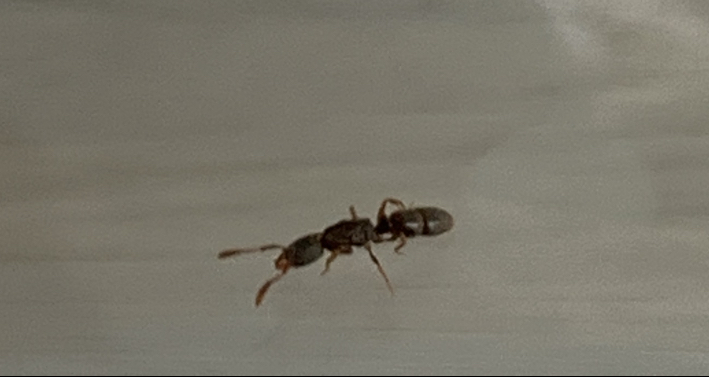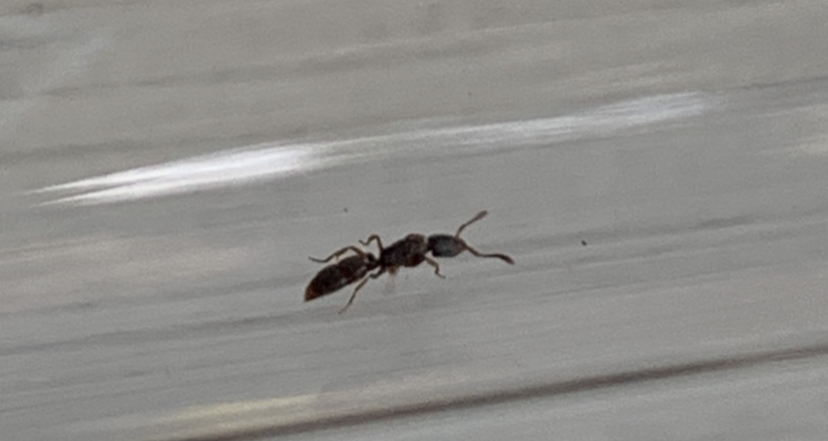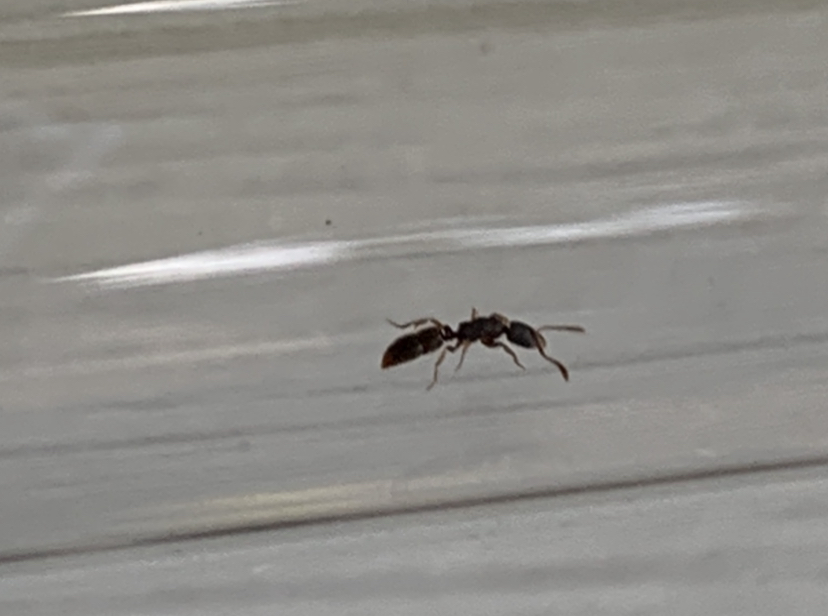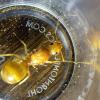- Formiculture.com
- Forums
- Gallery
- Members
- Member Map
- Chat
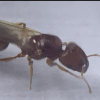
North eastern Midwest possibly semi-claustral 4-22-21
Started By
yibsi
, Apr 22 2021 1:10 PM

Best Answer VoidElecent , April 22 2021 - 2:05 PM
This is either a Ponera pennsylvanica or Hypoponera opacior queen. Depending on how "northern" you are, I'd venture that this is more likely to be Ponera than Hypoponera. If you have some method of magnification, you can check the underside of your ant's petiole; two tooth-like spines near the rear would confirm this ID.
Go to the full post
6 replies to this topic
#1
 Offline
-
Posted April 22 2021 - 1:10 PM
Offline
-
Posted April 22 2021 - 1:10 PM
Found in the northern Midwest
Found around 3 o’ clock in day on 4-22-21
Found crawling on a rock in my backyard
Roughly 4.6 millimeters
Dark brown head and gastor with a reddish thorax and a bright orangish reddish tip on her gastor as well. Her antenna are bright orange too, like that of a tetramorium queen.
In the first photo you can very clearly see her wing scars, and she has prominent orange antennae like that of a tetramorium queen.
She has a very hard time walking on glass, so much so that the slightest incline in the test tube and she slides to the other side of the tube, like throwing a rock on a frozen pond.
No nest
Unknown when she flew as she looks kind of like a semi-claustral queen, so she could have been out looking for food.
Found around 3 o’ clock in day on 4-22-21
Found crawling on a rock in my backyard
Roughly 4.6 millimeters
Dark brown head and gastor with a reddish thorax and a bright orangish reddish tip on her gastor as well. Her antenna are bright orange too, like that of a tetramorium queen.
In the first photo you can very clearly see her wing scars, and she has prominent orange antennae like that of a tetramorium queen.
She has a very hard time walking on glass, so much so that the slightest incline in the test tube and she slides to the other side of the tube, like throwing a rock on a frozen pond.
No nest
Unknown when she flew as she looks kind of like a semi-claustral queen, so she could have been out looking for food.
Nylanderia parvula - 4 queen polygynous colony with larvae + devoloping workers
Camponotus pennsylvanicus - 1 queen with 2 cocoons, and a few larvae and eggs
Tetramorium immigrans - 3 colonies, first nanetics!
Formica pallidifulva - 1 queen, 8-10 eggs
Tetramorium atratulum - 1 queen with roughly 17 host workers
![]() Pheidole pilifera - 1 queen! recently caught!
Pheidole pilifera - 1 queen! recently caught! ![]()
Solenopsis Molesta - 2 queens so far, polygenous set-up
---------------------------------------------------
My Ant Journal - yibsi’s Wonderful Ant Keeping Journal 5-22-21 - Ant Keeping Journals - Ants & Myrmecology Forum (formiculture.com)
My T. Atratulum Journal - https://www.formicul...ontinued/page-2
#2
 Offline
-
Posted April 22 2021 - 1:13 PM
Offline
-
Posted April 22 2021 - 1:13 PM
Looks like a cryptic but not sure the genus. Ask ponerinecat. They’re good with cryptics.
Edited by ZTYguy, April 22 2021 - 1:14 PM.
Currently: Considering moving to Australia
Reason: Myrmecia
Reason: Myrmecia
#3
 Offline
-
Posted April 22 2021 - 2:05 PM
Best Answer
Offline
-
Posted April 22 2021 - 2:05 PM
Best Answer
This is either a Ponera pennsylvanica or Hypoponera opacior queen. Depending on how "northern" you are, I'd venture that this is more likely to be Ponera than Hypoponera. If you have some method of magnification, you can check the underside of your ant's petiole; two tooth-like spines near the rear would confirm this ID.
- CheetoLord02 and Swirlysnowflake like this
#4
 Offline
-
Posted April 22 2021 - 2:27 PM
Offline
-
Posted April 22 2021 - 2:27 PM
Yup, she is a Ponera Pennsylvanicus Queen, that just about solves this then.
Nylanderia parvula - 4 queen polygynous colony with larvae + devoloping workers
Camponotus pennsylvanicus - 1 queen with 2 cocoons, and a few larvae and eggs
Tetramorium immigrans - 3 colonies, first nanetics!
Formica pallidifulva - 1 queen, 8-10 eggs
Tetramorium atratulum - 1 queen with roughly 17 host workers
![]() Pheidole pilifera - 1 queen! recently caught!
Pheidole pilifera - 1 queen! recently caught! ![]()
Solenopsis Molesta - 2 queens so far, polygenous set-up
---------------------------------------------------
My Ant Journal - yibsi’s Wonderful Ant Keeping Journal 5-22-21 - Ant Keeping Journals - Ants & Myrmecology Forum (formiculture.com)
My T. Atratulum Journal - https://www.formicul...ontinued/page-2
#5
 Offline
-
Posted April 23 2021 - 4:52 AM
Offline
-
Posted April 23 2021 - 4:52 AM
Yup, she is a Ponera Pennsylvanicus Queen, that just about solves this then.
Are you just saying that after looking at pictures or did you use a microscope or a macro photo to check her petiole? I'm not trying to offend you I've just seen a lot of people jump to conclusions after they see a species of ant that looks similar to theirs. It probably doesn't matter too much as from my understanding they have basically the same care.
Edited by Kaelwizard, April 23 2021 - 4:53 AM.
- gcsnelling and TennesseeAnts like this
#6
 Offline
-
Posted April 23 2021 - 10:40 AM
Offline
-
Posted April 23 2021 - 10:40 AM
Are you just saying that after looking at pictures or did you use a microscope or a macro photo to check her petiole? I'm not trying to offend you I've just seen a lot of people jump to conclusions after they see a species of ant that looks similar to theirs. It probably doesn't matter too much as from my understanding they have basically the same care.Yup, she is a Ponera Pennsylvanicus Queen, that just about solves this then.
Yes I was able to get a macro photo and she does have a the little hook on the bottom of her petiole, thus confirming she is a ponera sp.
Edited by yibsi, April 23 2021 - 10:40 AM.
- VoidElecent and Kaelwizard like this
Nylanderia parvula - 4 queen polygynous colony with larvae + devoloping workers
Camponotus pennsylvanicus - 1 queen with 2 cocoons, and a few larvae and eggs
Tetramorium immigrans - 3 colonies, first nanetics!
Formica pallidifulva - 1 queen, 8-10 eggs
Tetramorium atratulum - 1 queen with roughly 17 host workers
![]() Pheidole pilifera - 1 queen! recently caught!
Pheidole pilifera - 1 queen! recently caught! ![]()
Solenopsis Molesta - 2 queens so far, polygenous set-up
---------------------------------------------------
My Ant Journal - yibsi’s Wonderful Ant Keeping Journal 5-22-21 - Ant Keeping Journals - Ants & Myrmecology Forum (formiculture.com)
My T. Atratulum Journal - https://www.formicul...ontinued/page-2
#7
 Offline
-
Posted April 23 2021 - 11:23 AM
Offline
-
Posted April 23 2021 - 11:23 AM
Well good luck and if you have questions I might be able to help.Are you just saying that after looking at pictures or did you use a microscope or a macro photo to check her petiole? I'm not trying to offend you I've just seen a lot of people jump to conclusions after they see a species of ant that looks similar to theirs. It probably doesn't matter too much as from my understanding they have basically the same care.Yup, she is a Ponera Pennsylvanicus Queen, that just about solves this then.
Yes I was able to get a macro photo and she does have a the little hook on the bottom of her petiole, thus confirming she is a ponera sp.
1 user(s) are reading this topic
0 members, 1 guests, 0 anonymous users



